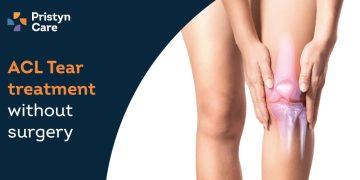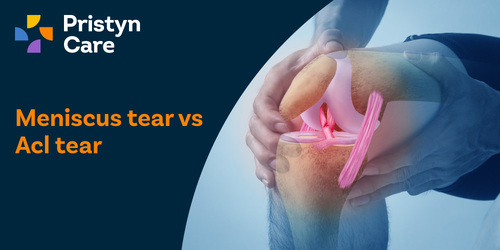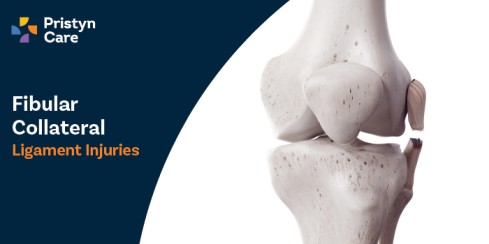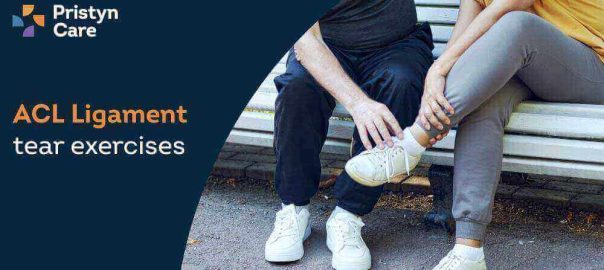![]() Views: 320
Views: 320
ACL Tear Treatment Without Surgery
But is avoiding the operating table the best choice? .
Dedicated Support at Every Step!
Our Doctors are available 24 hours a day, 7 days a week to help you!
Call Us9513-316-643In this blog, we will explore the full spectrum of non-surgical treatments, while also revealing why, despite their appeal, surgery often stands out as the most effective path to a complete and lasting recovery.
Table of Contents
ACL Tear Treatment Without Surgery: Exploring Your Options
The ACL plays a critical role in stabilising the knee joint, and when it’s torn, it can significantly impair movement and lead to long-term complications if not properly treated. For many, the thought of surgery is daunting, leading them to explore non-surgical treatment options first.
Below are the various non-surgical methods for managing an ACL tear and then discuss why surgery often emerges as the most effective solution for full recovery.
Non-Surgical Management of ACL Tears
Non-surgical treatments, often referred to as conservative management, focus on reducing pain, improving knee function, and preventing further injury. These methods are particularly appealing to those looking to avoid the risks and recovery time associated with surgery.
Below, we explore some of the most common non-surgical approaches to ACL tear treatment.
1. Physical Therapy
Physical therapy is the cornerstone of non-surgical ACL tear management. A tailored rehabilitation program can help strengthen the muscles around the knee, improve flexibility, and enhance joint stability. The focus is on building strength in the quadriceps and hamstrings, which can help compensate for the torn ligament.
- Strengthening Exercises: Exercises such as leg presses, hamstring curls, and squats can be incorporated into a physical therapy routine to bolster the surrounding muscles.
- Range of Motion Exercises: To maintain and improve the knee’s flexibility, exercises that promote a full range of motion are essential. This helps prevent stiffness and aids in overall knee function.
- Balance and Proprioception Training: These exercises help retrain the body to maintain balance and stability, crucial for preventing further injury.
While physical therapy can significantly improve knee function, it often requires a long-term commitment and consistent effort. For some, it may allow them to return to daily activities or low-impact sports, but it typically does not restore the knee to its pre-injury level.
2. Bracing
Knee braces are often used in conjunction with physical therapy to provide additional support to the knee joint. Braces can help stabilise the knee, particularly during activities that involve pivoting or sudden changes in direction.
- Functional Braces: These are designed to support the knee during movement, allowing for some degree of physical activity while reducing the risk of further injury.
- Prophylactic Braces: Typically used as a preventive measure, these braces are designed to protect the knee from injury during contact sports.
However, bracing is more of a supportive measure than a standalone treatment. It may provide temporary relief and allow for some level of activity, but it does not address the underlying instability caused by the ACL tear.
3. Activity Modification
For some individuals, particularly those who are not heavily involved in sports or physically demanding activities, modifying their daily routines can be a practical approach. This might include avoiding activities that put stress on the knee, such as running, jumping, or sports that involve sudden changes in direction.
- Low-Impact Activities: Engaging in low-impact exercises like swimming or cycling can help maintain fitness without putting undue stress on the knee.
- Lifestyle Adjustments: Simple changes like avoiding stairs or using assistive devices can help prevent further strain on the knee.
While activity modification can be effective in reducing symptoms and preventing further injury, it often comes at the cost of giving up or significantly altering one’s physical activities. This approach may be suitable for older individuals or those with lower activity levels, but it’s less ideal for those who want to maintain an active lifestyle.
4. Pain Management
Managing pain is a critical aspect of non-surgical treatment for ACL tears. Various methods can be employed to reduce pain and inflammation in the knee.
- Medications: Non-steroidal anti-inflammatory drugs (NSAIDs) like ibuprofen can help manage pain and reduce inflammation.
- Cold Therapy: Applying ice packs to the knee can help reduce swelling and alleviate pain.
- Injections: In some cases, corticosteroid injections may be used to reduce inflammation and provide temporary pain relief.
While these methods can help manage the symptoms of an ACL tear, they do not address the underlying issue of knee instability. Pain management is often used in conjunction with other non-surgical treatments.
No Cost EMI, Hassle-free Insurance Approval
The Limitations of Non-Surgical Treatment
While non-surgical treatments can be effective in managing symptoms and improving knee function, they come with significant limitations. One of the primary concerns is that these treatments often do not restore the knee’s full stability.
Without a functioning ACL, the knee remains vulnerable to further injury, particularly during activities that involve pivoting or sudden changes in direction. Over time, this can lead to chronic knee instability, increased wear and tear on the joint, and a higher risk of developing osteoarthritis.
Why Surgery Often Becomes Necessary?
For many individuals, particularly those who are young, active, or involved in sports, surgery often becomes the preferred option for treating an ACL tear. The goal of surgical treatment is to reconstruct the torn ligament, restoring stability to the knee and allowing for a return to pre-injury levels of activity.
1. ACL Reconstruction Surgery
ACL reconstruction is the most common surgical procedure for treating a torn ACL. During this procedure, the surgeon replaces the torn ligament with a graft, which is typically taken from the patient’s own hamstring or patellar tendon.
- Graft Selection: The graft can be harvested from the patient’s own body (autograft) or from a donor (allograft). Autografts are generally preferred because they have a lower risk of rejection.
- Surgical Procedure: The surgery is typically performed arthroscopically, which is minimally invasive and allows for a faster recovery.
- Recovery Time: Full recovery from ACL reconstruction can take six to nine months, during which time physical therapy is crucial to regain strength and stability in the knee.
2. Post-Surgical Rehabilitation
Rehabilitation is a critical component of recovery after ACL surgery. The goal is to restore full knee function, including strength, flexibility, and range of motion.
- Phase 1: The initial phase focuses on reducing swelling and pain, regaining range of motion, and beginning gentle strengthening exercises.
- Phase 2: The second phase involves more intensive strengthening and balance exercises to restore stability to the knee.
- Phase 3: The final phase prepares the patient for a return to full activity, including sport-specific drills and exercises.
Successful rehabilitation is essential for a full recovery, and patients who adhere to their rehabilitation program are more likely to regain their pre-injury level of activity.
Conclusion
While non-surgical treatments for ACL tears can be effective for some individuals, particularly those with lower activity levels or less severe injuries, they often fall short of providing the full stability and function that many patients desire.
For those who wish to return to an active lifestyle, particularly athletes, ACL reconstruction surgery is often the best option.
The surgery not only restores stability to the knee but also significantly reduces the risk of further injury and long-term complications. If you’re facing an ACL tear, it’s essential to weigh your options carefully and consider what will best serve your long-term health and mobility.
Frequently Asked Questions
Q1. Can an ACL tear heal on its own without surgery?
No, an ACL tear cannot heal on its own. While non-surgical treatments can manage symptoms, the ligament won’t naturally reattach or regenerate. Surgery is often necessary to restore full knee stability and function.
Q2. What activities should I avoid with a torn ACL?
With a torn ACL, avoid high-impact activities like running, jumping, or sports involving sudden direction changes. These movements can exacerbate the injury and increase the risk of further damage to the knee joint.
Q3. Is it safe to exercise with an ACL tear?
Yes, but only low-impact exercises like swimming or cycling are recommended. These activities help maintain fitness without putting excessive strain on the knee, minimising the risk of worsening the injury.
Q4. How long can I delay ACL surgery?
You can delay ACL surgery for a few weeks to months, depending on your symptoms. However, prolonged delay increases the risk of further knee damage and instability, especially if you remain active.
Q5. Can braces prevent ACL tears?
While braces can provide additional knee support, they cannot fully prevent ACL tears. Proper conditioning, strength training, and flexibility exercises are more effective in reducing the risk of an ACL injury.
Q6. Are there any non-invasive alternatives to ACL surgery?
No fully non-invasive alternatives can replace the effectiveness of ACL surgery. Non-surgical treatments like physical therapy, bracing, and pain management can help but won’t restore full knee stability or function.
Q7. What is the success rate of ACL surgery?
ACL reconstruction surgery has a success rate of approximately 85-90%. Most patients regain full knee stability and return to their pre-injury activity levels following proper rehabilitation.
Q8. Is ACL surgery painful?
While ACL surgery involves discomfort, pain is typically managed with anaesthesia during the procedure and pain medications afterward. Post-surgery rehabilitation focuses on reducing pain and swelling while restoring knee function.
Q9. Can you live with a torn ACL?
Yes, but it may limit your physical activity and increase the risk of further knee injuries. Surgery is often recommended for active individuals seeking to maintain a high level of activity.
Q10. Does an ACL tear lead to arthritis?
An untreated ACL tear increases the risk of developing osteoarthritis in the knee over time due to chronic instability and increased wear and tear on the joint. Surgery can help reduce this risk.











